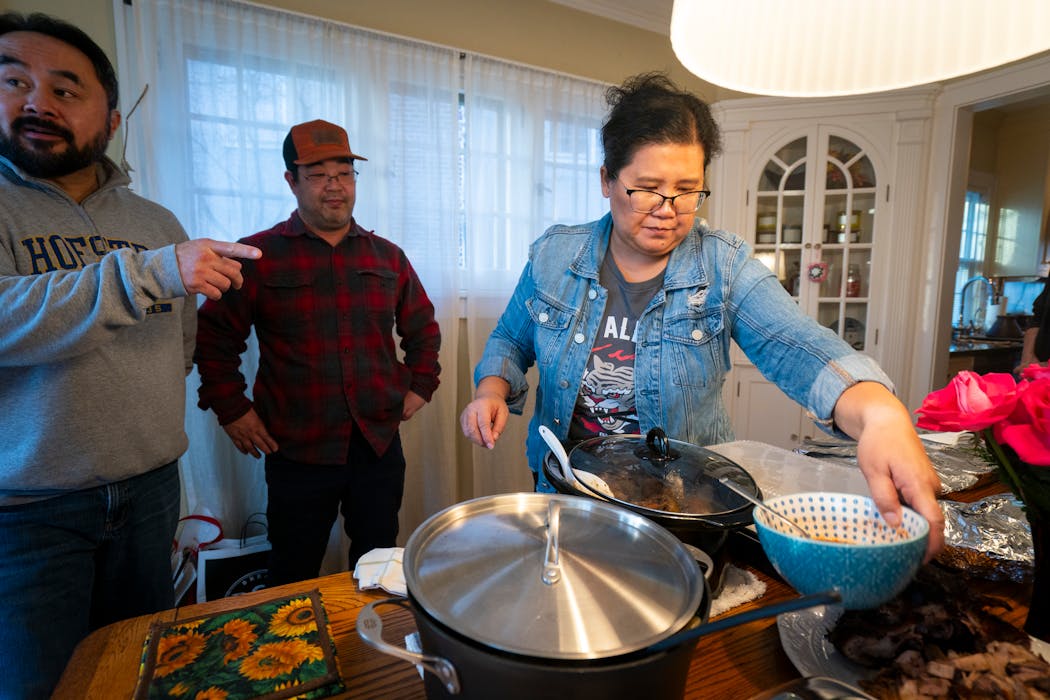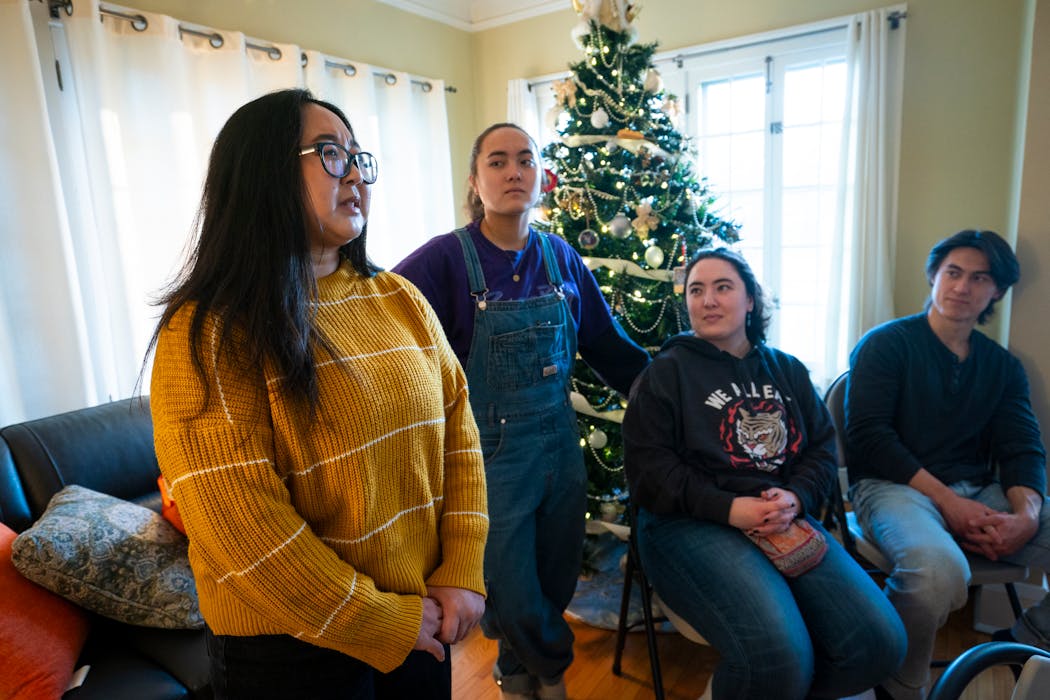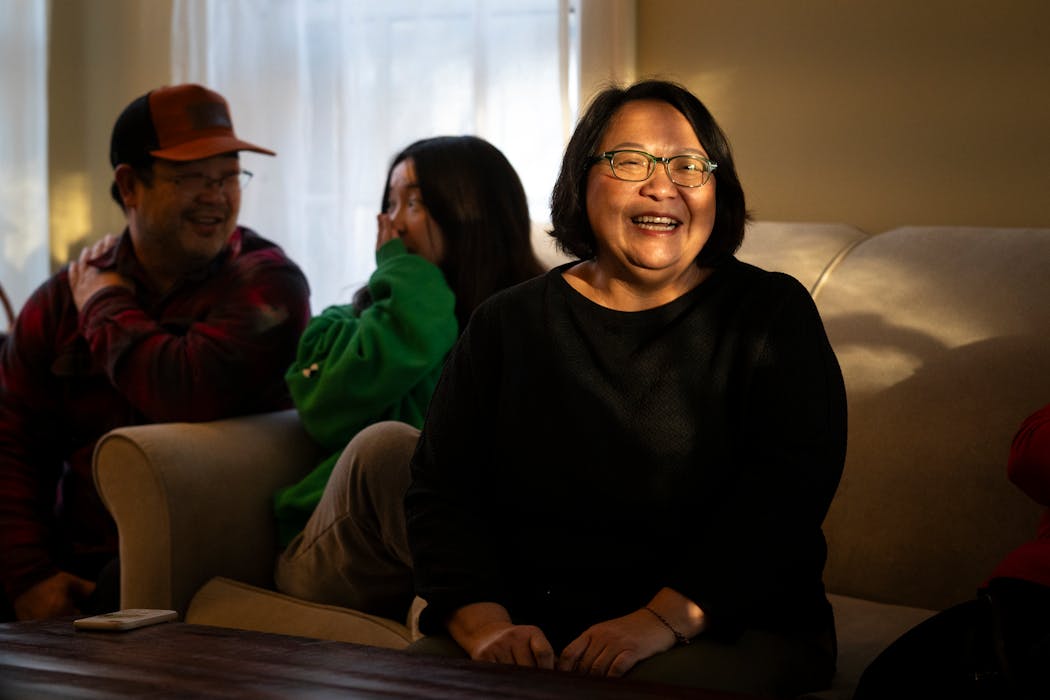You don't have to be rich to be a philanthropist.
But that's who Americans often think are writing the big checks, whether it's the affluent backers of a beloved art museum or those hosting black-tie galas for an important charity.
The philanthropists I met over a Sunday potluck in St. Paul are not wealthy. Most of them aren't white, for that matter. A decade ago, they formed a giving circle, a group of friends with shared values who pool their money to make a much larger charitable gift than they could on their own.
About a dozen Asian American families make up Building More Philanthropy with Purpose (BMPP). But that's just their official name. The acronym also stands for Bad Mo Pho Phamily, a punny nod to the founding members' Southeast Asian roots and affinity for the noodle soups.
"We believe we're all bad mo' phos," cracked Kong Her, who with his wife, state Rep. Kaohly Her, roasted a pig and opened their home for the group's end-of-year potluck.
And by joining forces, the families have made outsized impact. Over the 10 years they've been together, BMPP has given $300,000 to more than 60 causes. They've steered microgrants toward small but meaningful projects, like a girls soccer team in the Karen refugee community, a youth leadership conference for St. Paul Public Schools, and a point-of-sale system for Hmong farmers.
"None of us are millionaires," said founding member Bo Thao-Urabe, a member of the University of Minnesota Board of Regents. "All of us are very average American families that are making our ends meet, but we prioritize how we participate in philanthropy."
Collective giving is on the rise in the United States, with more than 2,500 giving circles established over the past two decades, according to the initiative Philanthropy Together. Proponents say the movement allows donors to be more intentional about their generosity and brings them closer to their communities.
Each household in BMPP contributes at least $1,000 a year. As a group, they meet several times a year to review proposals, hear from the artists or groups that they've supported, take stock of the giving circle's impact, and of course, share celebratory bowls of pho. It's housed under the Minneapolis Foundation, which hosts a number of giving circles and cuts the actual checks to the grant recipients.
Thao-Urabe, a career veteran in philanthropic and nonprofit work, knew she wanted to start the circle after reading reports of how few charitable dollars go toward Asian American causes. For every $100 awarded by foundations for work in the United States, only 20 cents is designated for Asian American communities, according to the Asian Americans/Pacific Islanders in Philanthropy.
Those kinds of statistics belie the mountains of need among some Asian Americans, Thao-Urabe said. And they don't account for the radical generosity in her Hmong community, where people give liberally at funerals, births, weddings or in times of crisis. She yearned to make philanthropy more accessible to Asian Americans, on both the giving and receiving end.
Stereotypes about philanthropists — that they are older, wealthy and white — descended on Thao-Urabe when she made a sizable contribution to a foundation years ago. When she showed up to a high-donor event, the staff didn't recognize her and other donors assumed she was a grant recipient.
"They treated me like they somehow had helped me through their generosity," Thao-Urabe said. "Why do we think donors are not people who look like us?"
Her frustrations led her to create the giving circle in 2012. She invited two friends, Terri Thao and Kaohly Her, and the women were game. Their kids have since grown up together, sometimes bypassing their own birthday presents so their families could support others. The circle has expanded over the years, and the projects have branched well outside the Asian American community. The families are united by their No. 1 rule: The giving and the gatherings need to be fun.
Thao-Urabe's 12-year-old daughter, Emi, said her favorite event is the "flashgiving" celebration. That's when grant recipients come back to update the circle and additional community members about their projects. Audiences can scan a QR code and vote for their favorite project. The winner gets an additional pot of money raised on the spot.
"It makes me feel better, helping out other people with my money," Emi said.
BMPP does a fair amount of organization and goal-setting, but Thao-Urabe says other bands of friends could form their own giving circles with far less structure. She says it could be as simple as deciding to support a nonprofit's annual fund-raiser.
"The purpose of a giving circle is to aggregate resources and give to priority areas," she said. "If that means you all want to show up at a gala and attend as a group, that makes a difference."
A $5,000 gift in 2015 to an Asian American female comedy troupe known as Funny Asian Women Kollective (FAWK) made a huge difference in the troupe's early days. "We were very scrappy back then," recalls co-founder Saymoukda Duangphouxay Vongsay. "We would accept $50 to do a one-hour workshop, and the three of us would split that $50."
Back then, it was hard to sell the idea that stand-up comedy was performance art worth investing in. But the group's comedy, Vongsay said, was just an entry point for a much bigger undertaking: helping empower Asian American women to address microaggressions and other forms of bias. "To our amazement, the families of BMPP thought that was valuable," she said.
With that initial microgrant, which helped FAWK pay artists, the comedy organization was able to make the case to larger funders that its mission was worth supporting.
And when Vongsay, a self-proclaimed starving artist, won a three-year paid Mellon playwright residency in 2020, she knew she was financially secure enough to keep the good karma going. The Lao American writer, who was born in a Thai refugee camp, decided to join BMPP.
"It feels so good to be able to do that. My dad has this saying that when we came to this country after the war, we had our hands out, our palms facing up," she said. "Now that we're in a position where we can give back, we can turn our hand the other way, palm facing down. Now we can be the ones who give."
Yuen: The bizarre and relatable case of Minnesota state Sen. Nicole Mitchell

Yuen: Lynx No. 1 pick Pili finds 'blessing' fueling dreams of Samoan, Indigenous kids

Yuen: Why do people forgive? It's messy, complex and 'the best form of self-interest'

Your fridge is a place where fresh food goes to die. That doesn't have to happen.







